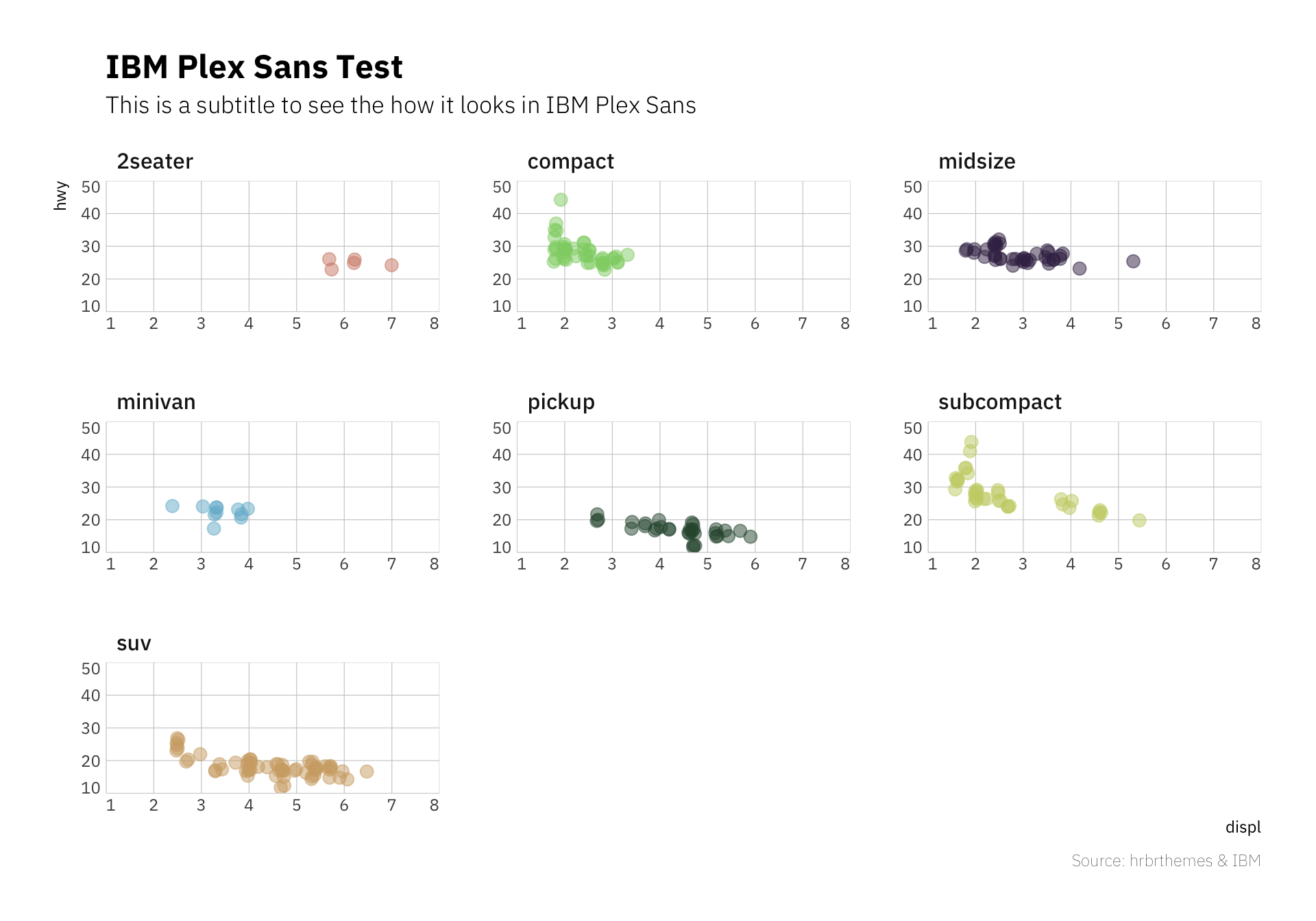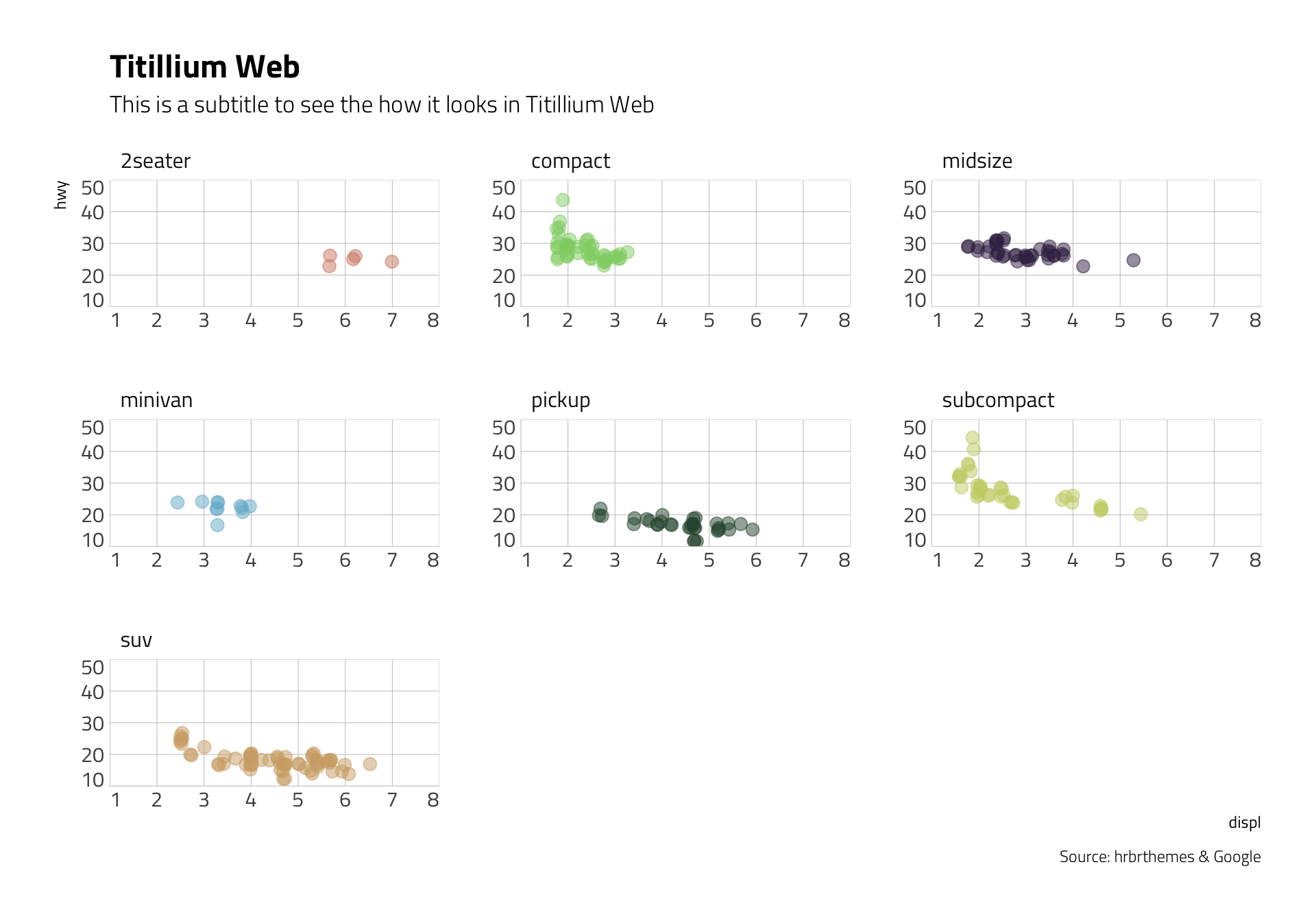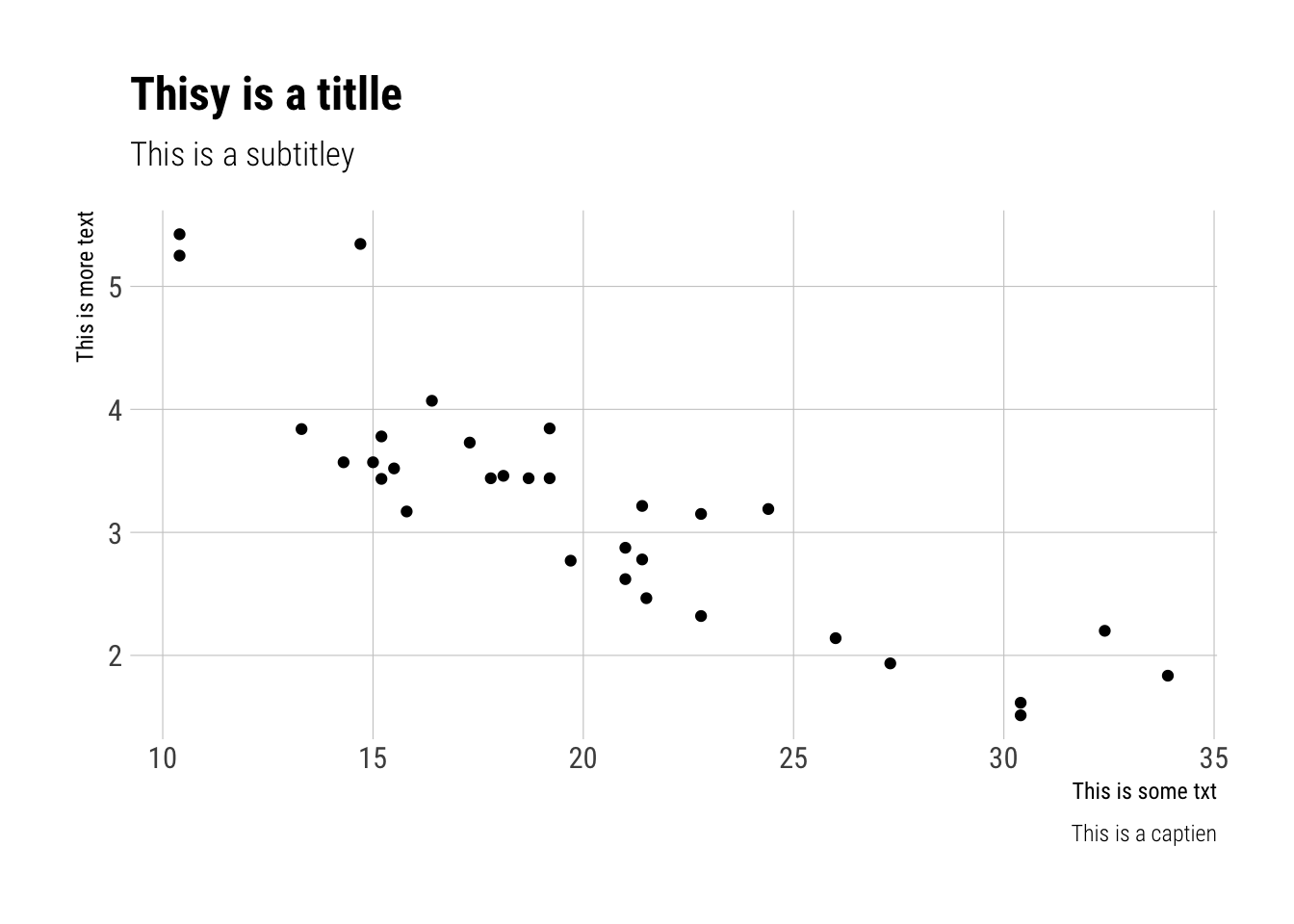This is a very focused package that provides typography-centric themes
and theme components for ggplot2. It’s a an extract/riff of
hrbrmisc created by request.
The core theme: theme_ipsum (“ipsum” is Latin for “precise”) uses
Arial Narrow which should be installed on practically any modern system,
so it’s “free”-ish. This font is condensed, has solid default kerning
pairs and geometric numbers. That’s what I consider the “font trifecta”
must-have for charts. An additional quality for fonts for charts is that
they have a diversity of weights. Arial Narrow (the one on most systems,
anyway) does not have said diversity but this quality is not (IMO) a
“must have”.
The following functions are implemented/objects are exported:
Core themes & scales:
theme_ipsum: Arial Narrow-based themetheme_ipsum_ps: IBM Plex Sans-based themetheme_ipsum_rc: Roboto Condensed-based themetheme_ipsum_tw: Titillium Web-based themescale_x_comma/scale_y_comma: Comma format for axis text and betterexpanddefaults (you need to set limits)scale_x_percent/scale_y_percent: Percent format for axis text andexpand=c(0,0)(you need to set limits)scale_color_ipsum/scale_fill_ipsum/ipsum_pal: A muted discrete color palette with 9 colors
Utilities:
flush_ticks: Makes axis text labels flush on the endsgg_check: Spell check ggplot2 plot labelsupdate_geom_font_defaults: Update font defaults for text geoms (the default is — unsurprisingly — Arial Narrow)
R Markdown:
ipsum: minimalistic HTML templateipsum_pdf: everything you need to use hrbrthemes in PDFs
The following global variables are now in your namespace:
font_an: a short global alias for “Arial Narrow”font_ps: a short global alias for “IBMPlexSans”font_ps_light: a short global alias for “IBMPlexSans-Light”font_rc: a short global alias for “Roboto Condensed”font_rc_light: a short global alias for “Roboto Condensed Light”font_tw: a short global alias for “Titillium Web”font_tw_bold: a short global alias for “Titillium Web Bold” (NOTE: may be an issue with name on macOS 10.13)font_tw_light: a short global alias for “Titillium Web Light” (NOTE: may be an issue with name on macOS 10.13)
devtools::install_github("hrbrmstr/hrbrthemes")library(hrbrthemes)
library(gcookbook)
library(tidyverse)
# current verison
packageVersion("hrbrthemes")
## [1] '0.5.0'ggplot(mtcars, aes(mpg, wt)) +
geom_point() +
labs(x="Fuel effiiency (mpg)", y="Weight (tons)",
title="Seminal ggplot2 scatterplot example",
subtitle="A plot that is only useful for demonstration purposes",
caption="Brought to you by the letter 'g'") +
theme_ipsum()ggplot(mtcars, aes(mpg, wt)) +
geom_point() +
labs(x="Fuel effiiency (mpg)", y="Weight (tons)",
title="Seminal ggplot2 scatterplot example",
subtitle="A plot that is only useful for demonstration purposes",
caption="Brought to you by the letter 'g'") +
theme_ipsum_rc()ggplot(mpg, aes(displ, hwy)) +
geom_jitter(aes(color=class, fill=class), size=3, shape=21, alpha=1/2) +
scale_x_continuous(expand=c(0,0), limits=c(1, 8), breaks=1:8) +
scale_y_continuous(expand=c(0,0), limits=c(10, 50)) +
scale_color_ipsum() +
scale_fill_ipsum() +
facet_wrap(~class, scales="free") +
labs(
title="IBM Plex Sans Test",
subtitle="This is a subtitle to see the how it looks in IBM Plex Sans",
caption="Source: hrbrthemes & IBM"
) +
theme_ipsum_ps(grid="XY", axis="xy") +
theme(legend.position="none") -> gg
flush_ticks(gg)
## theme(axis.text.x=element_text(hjust=c(0, rep(0.5, 6), 1))) +
## theme(axis.text.y=element_text(vjust=c(0, rep(0.5, 3), 1)))ggplot(mpg, aes(displ, hwy)) +
geom_jitter(aes(color=class, fill=class), size=3, shape=21, alpha=1/2) +
scale_x_continuous(expand=c(0,0), limits=c(1, 8), breaks=1:8) +
scale_y_continuous(expand=c(0,0), limits=c(10, 50)) +
scale_color_ipsum() +
scale_fill_ipsum() +
facet_wrap(~class, scales="free") +
labs(
title="Titillium Web",
subtitle="This is a subtitle to see the how it looks in Titillium Web",
caption="Source: hrbrthemes & Google"
) +
theme_ipsum_tw(grid="XY", axis="xy") +
theme(legend.position="none") -> gg
flush_ticks(gg)
## theme(axis.text.x=element_text(hjust=c(0, rep(0.5, 6), 1))) +
## theme(axis.text.y=element_text(vjust=c(0, rep(0.5, 3), 1)))ggplot(mtcars, aes(mpg, wt)) +
geom_point(aes(color=factor(carb))) +
labs(x="Fuel effiiency (mpg)", y="Weight (tons)",
title="Seminal ggplot2 scatterplot example",
subtitle="A plot that is only useful for demonstration purposes",
caption="Brought to you by the letter 'g'") +
scale_color_ipsum() +
theme_ipsum_rc()count(mpg, class) %>%
mutate(pct=n/sum(n)) %>%
ggplot(aes(class, pct)) +
geom_col() +
scale_y_percent() +
labs(x="Fuel effiiency (mpg)", y="Weight (tons)",
title="Seminal ggplot2 column chart example with percents",
subtitle="A plot that is only useful for demonstration purposes",
caption="Brought to you by the letter 'g'") +
theme_ipsum(grid="Y")ggplot(uspopage, aes(x=Year, y=Thousands, fill=AgeGroup)) +
geom_area() +
scale_fill_ipsum() +
scale_x_continuous(expand=c(0,0)) +
scale_y_comma() +
labs(title="Age distribution of population in the U.S., 1900-2002",
subtitle="Example data from the R Graphics Cookbook",
caption="Source: R Graphics Cookbook") +
theme_ipsum_rc(grid="XY") +
theme(axis.text.x=element_text(hjust=c(0, 0.5, 0.5, 0.5, 1))) +
theme(legend.position="bottom")update_geom_font_defaults(font_rc_light)
count(mpg, class) %>%
mutate(n=n*2000) %>%
arrange(n) %>%
mutate(class=factor(class, levels=class)) %>%
ggplot(aes(class, n)) +
geom_col() +
geom_text(aes(label=scales::comma(n)), hjust=0, nudge_y=2000) +
scale_y_comma(limits=c(0,150000)) +
coord_flip() +
labs(x="Fuel effiiency (mpg)", y="Weight (tons)",
title="Seminal ggplot2 column chart example with commas",
subtitle="A plot that is only useful for demonstration purposes, esp since you'd never\nreally want direct labels and axis labels",
caption="Brought to you by the letter 'g'") +
theme_ipsum_rc(grid="X")df <- data.frame(x=c(20, 25, 30), y=c(4, 4, 4), txt=c("One", "Two", "Three"))
ggplot(mtcars, aes(mpg, wt)) +
geom_point() +
labs(x="This is some txt", y="This is more text",
title="Thisy is a titlle",
subtitle="This is a subtitley",
caption="This is a captien") +
theme_ipsum_rc(grid="XY") -> gg
gg_check(gg)
## Possible misspelled words in [title]: (Thisy, titlle)
## Possible misspelled words in [subtitle]: (subtitley)
## Possible misspelled words in [caption]: (captien)library(hrbrthemes)
date()
## [1] "Wed Mar 7 16:33:01 2018"
devtools::test()
## ✔ | OK F W S | Context
##
⠏ | 0 | basic functionality
⠋ | 1 | basic functionality
⠙ | 2 | basic functionality
⠹ | 3 | basic functionality
⠸ | 4 | basic functionality
⠼ | 5 | basic functionality
⠴ | 6 | basic functionality
⠦ | 7 | basic functionality
⠧ | 8 | basic functionality
⠇ | 9 | basic functionality
⠏ | 10 | basic functionality
✔ | 10 | basic functionality [1.7 s]
##
⠏ | 0 | themes
##
⠋ | 1 | themes
##
⠙ | 2 | themes
✔ | 2 | themes [0.6 s]
##
## ══ Results ═══════════════════════════════════════════════════════════════
## Duration: 2.3 s
##
## OK: 12
## Failed: 0
## Warnings: 0
## Skipped: 0Please note that this project is released with a Contributor Code of Conduct. By participating in this project you agree to abide by its terms.








